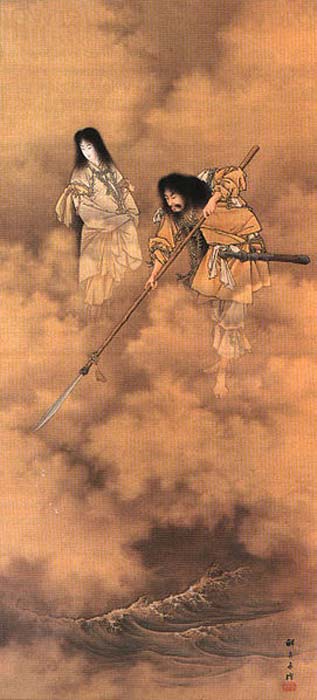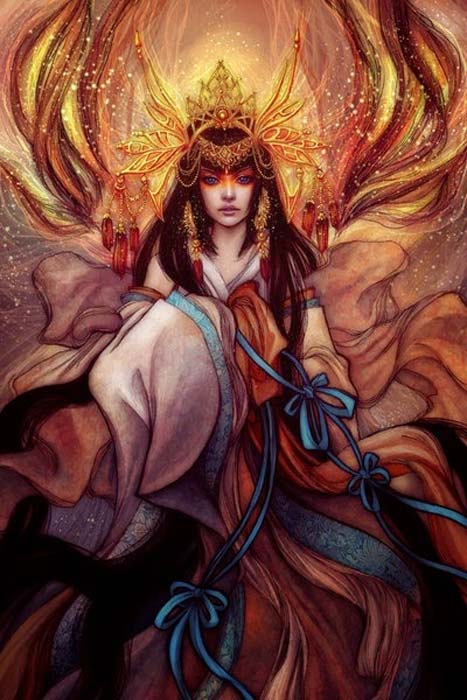
Solar Goddess Amaterasu, Divine Ancestor of the Japanese Imperial Family
Amaterasu is a major goddess in the Shinto religion. Although she is considered primarily a sun goddess, she is also believed to be the ruler of the Takama no Hara (the High Celestial Plain), which is the realm of the kami or spirits. This goddess has also been identified as the key ancestor for all Emperors of Japan.
The Japanese monarchy is regarded as the oldest continuous hereditary monarchy in the world, with its roots extending all the way back to the 7th century BC. Like many other ancient monarchies, the Emperors of Japan trace their ancestry to a divine source, though it may be said that there are certain differences between the divinity of the Japanese Emperor and those of other rulers who claimed divinity.
According to Shinto religion, Amaterasu was the daughter of Izanagi and Izanami, two primordial deities who are believed to be responsible for the creation of the islands of Japan. Amaterasu was born when her father, Izanagi, escaped from the Underworld, following his failed attempt to rescue his dead wife. In the River Woto, Izanagi performed a purification ritual in order to cleanse himself. As the god was washing his left eye, Amaterasu was born.
- A Cycle of Life and Death: Slavic Goddesses Morana and Vesna
- Meenakshi: The Warrior Goddess Who Could Not Be Defeated by Any Man …Until She Met Shiva
- Magu: The Hemp Goddess Who Healed Ancient Asia

Kobayashi Eitaku, Izanagi and Izanami, c. 1885. (Public Domain)
Why is Amaterasu Important?
There are various myths about Amaterasu, the best-known of which is arguably the one in which the goddess blocked herself in a cave following a conflict with her younger brother, Susanoo, the god of the sea and storms. The latter was causing chaos on earth by destroying rice fields, uprooting trees, and even demolishing sacred buildings. Amaterasu’s patience reached its breaking point when her brother broke a hole in the roof of the hall where the goddess was sitting and watching the other gods weave the heavenly garments, and he threw in the body of a huge, flayed horse. Many of the weavers were hurt and some even died.

A modern depiction of Amaterasu. (Dragons Fairies Elves & the Unseen)
As a result of this act, Amaterasu decided to retreat into a cave in the center of the earth, known as Ama-no-Iwato (the Rock Cave), and refused to come out, thus plunging the world into total darkness. The other deities (800 in total) entreated the sun goddess to come out of the cave with no avail. Finally, it was through a ruse, by making the goddess think that they had found someone / something that could take her role in bringing light to the world. As Amaterasu opened the door of the cave slightly to see what was going on, she was seized, brought out, and prevented from going back into the cave.

Amaterasu emerging from the cave. (Public Domain)
Amaterasu’s Imperial Relations and Their Roles
Before the legendary cave situation, Amaterasu is said to have taken her brother Susanoo’s sword and broken it into three pieces. She then ate the sword fragments and spat them out – creating three goddesses. Susanoo took a necklace of 500 jewels, ate it, and then spat out a mist which formed five gods. Combined, these eight deities are the mythical ancestors of Japanese nobility.
Amaterasu in particular had a grandson by the name of Ninigi-no-Mikoto, who became the ruler of the terrestrial world, as his father, Ama-no-Oshiho-mimi, refused to take on that role when he was offered it by his mother because he thought the world was too chaotic. Amaterasu gave her grandson three magical gifts to help him with his task. These gifts were Yasakani, a jewel / pearls, Yata, a mirror, and Kusanagi, a sword. These items would become known as the imperial regalia of the Emperors of Japan.
- Oshun, African Goddess of Love and Sweet Waters
- Celestial Goddess Selene: The Star of the Night
- Relics from the Niuheliang Goddess Temple, the most mysterious site of the ancient Hongshan
It was Ninigi’s great-grandson, Jimmu, who became the first Emperor of Japan in 660 BC. In other words, the Emperors of Japan trace their ancestry all the way back to the goddess Amaterasu herself. Throughout the history of Japan, the emperors have been considered as divine.
Nevertheless, this did not mean that the emperor was a supernatural being. Instead, it meant that he was responsible for carrying out certain rituals to ensure that the kami would protect Japan and maintain its prosperity. Moreover, the emperor had little political power for the greater part of Japanese history, until the Meiji Restoration.

A modern depiction of Amaterasu. (matiasdelcarmine /Adobe Stock)
Following the defeat of Japan by the Allies during the Second World War, the Emperor Hirohito was forced to renounce his divinity. According to revisionists, however, the divine status of the emperor had not changed following the war - it was just a piece of propaganda by the victors in their attempt to sever the connection between the emperor and the Japanese people. In any case, few Japanese people still worship the emperor today - some are even of the opinion that the Emperor no longer has a function in the modern world.
As for Amaterasu, she is still seen in Japanese art and culture, in which she’s often depicted as cheerful and bright. She’s sometimes presented in art alongside her brother, the moon god Tsukiyomi-no-Mikoto. Roosters and ravens are two popular symbols which are linked to the goddess – the first noting the sun’s arrival each day, and the second acting as her messengers. Finally, Amaterasu is honored in the most important Shinto shrine in Japan, the Ise Grand Shrine.

Painting of Amaterasu. (Aya Kato)
Top image: Amaterasu, a major goddess of Japan. Source: Dragons Fairies Elves & the Unseen
By: Wu Mingren
Updated on January 26, 2021.
References
Hoffman, M., 2009. Land of the Sun Goddess. [Online]
Available at: https://www.japantimes.co.jp/life/2009/07/12/general/land-of-the-sun-goddess/#.Wer8pFuCzIV
Japan Zone, 2016. The Imperial Family. [Online]
Available at: https://www.japan-zone.com/culture/imperial.shtml
New World Encyclopedia, 2016. Amaterasu. [Online]
Available at: http://www.newworldencyclopedia.org/entry/Amaterasu
The BBC, 2009. Divinity of the Emperor. [Online]
Available at: http://www.bbc.co.uk/religion/religions/shinto/history/emperor_1.shtml
Watts, J., 2002. Japan's revisionists turn emperor into a god once more. [Online]
Available at: https://www.theguardian.com/world/2002/aug/21/japan.jonathanwatts
















Comments
I think that's getting a bit too philosophical about the whole thing. Ancient times this is how they explain how the world is created and functions.... a specific diety / God for each role in the nature of the worlds existence. I don't think they created these stories to be philosophically pulled apart. Although in many cases these aren't just stories made up to explain how the world came to be... alot of these Gods / Goddesses were / are very real and they weren't taken very lightly either... in Ancient times the Gods / Goddesses were just as important as the air we breath or the food we eat. However the argument these days are... were these Gods just Aliens from another planet or were they from a place called heaven but the heaven that most people envision heaven to be?
This is a beautiful article and glad you posted it. I want to add to it. What lured her out of the cave was they (the deities) placed a mirror outside the cave, and when she saw the beautiful light filled Goddess in the mirror she was intrigued and curious. She did not know that it was herself she say in the mirror, her own light she saw. This is what caused her to come out.
Amaterasu meets the beauty of her reflection, but does not she herself. She can see her own light "only when she see's the light in others".
We are all sacred mirrors. That is her gift to us! When we see the light in others, we can see our own. This is the part you left out of the story. The power of this Goddess. She was not merely seized and forced out of the cave. She was lured out by her light-hearted curiosity to the Goddess in the mirror. She is the light, that is within everyone.